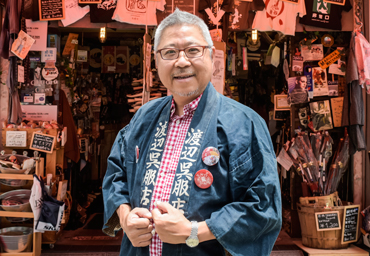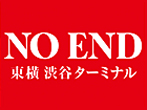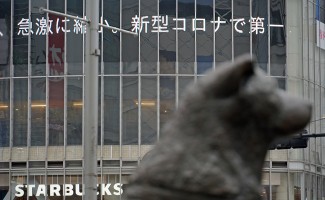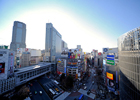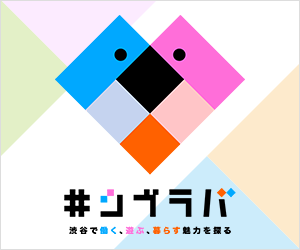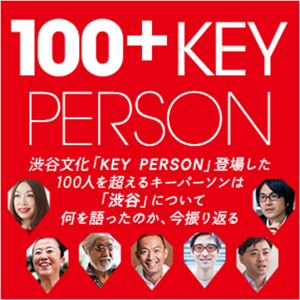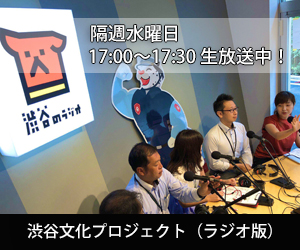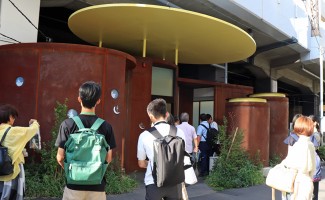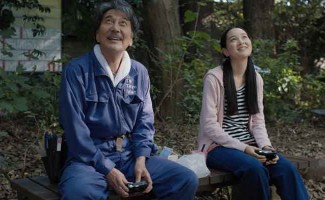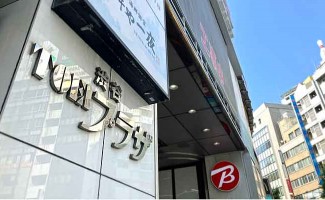"Japanese miscellaneous goods Shibuya Maruagori Watanabe" in Shibuya and Inokashiradori is known as a popular souvenir shop where foreign tourists rush. With a novel idea such as "souvenir vending machines" and "face squirrel post cards" we grab the hearts of foreign tourists cautiously. Currently, it is a shop dealing mainly with "Japanese miscellaneous goods", but originally it was a long-established store for kimono that continues from Taisho era. Twenty years ago, Watanabe Kinji (Watanabe Yoshitsugu) who is the founder's grandchild succeeded the shopkeeper of the 3rd generation and transformed the business style to "Japanese grocery store" for young people and foreigners at once. We have attracted a large number of tourists by our dedicated overseas local research, unique methods that do not use advertisements and SNS at all. In this key person interview, we welcomed the 3rd shop owner, Mr. Kinji, who is the leader in Shibuya's inbound, and from the circumstances of business transformation to Japanese miscellaneous goods, we will carefully listen to the unique ideas that attract foreign tourists It was. Well, what will happen to the inbound after the 2020 Tokyo Olympics?
From a business kimono shop for business, gal, to a Japanese grocery shop for foreigners
_ The history of "Japanese miscellaneous goods Shibuya Maruagori Watanabe" is going back to the Kimono ya shop that Mr. Watanabe's grandfather founded.
Founders are grandfather Arashi Watanabe (Watanabe). A grandfather from Kawaguchiko, Yamanashi Prefecture, came to Shibuya as a gift apprentice. After the Great Kanto Earthquake, as a kimono dealer in the Taisho 14 (1925) year, he got independent, but initially he did not have a shop and was carrying jogor who carried him around Shibuya station. Finally, the funds were also accumulated, and in the year of the end of the war in 1945 (1945), we opened the "Maruaru Watanabe Kimono Store" in the same place as the present place (along Inokashira Street). There was a transformation of business in the middle, but since my grandfather started peddling with my grandfather, this year is my 92nd year. "Maruaru (Maruaru)" of the current shop name "Japanese miscellaneous goods Shibuya Maruaki Watanabe" is the shop name of the Kimonosa era taken from the name of Arai.
_ Since when did Mr. Yinji (Yoshitsugu) succeed the third generation?

After graduating from university, I worked as an electrical manufacturer for about 14 years, but in 1997 I left the company and took over my 3rd generation. Nonetheless, since my grandmother died in 1984, the business of Kimonoya got wrong and I was not in a situation to go on. It is not only outdoors, it is getting hard for the business itself as a kimono ya who gets an order and gets an order. There used to be many kimono shops in Shibuya in the past, but is it about the Tamagawa shop in Dogenzaka that is open now? Considering calmly, the fact that the business of the Kimono shop became useless was because it was business-oriented business in the first place. Well then, I wonder if you can change to a free customer who is walking in front of you, to a business that seizes these people. However, even if we change the items to sell or the business style, I thought that we should not change only suppliers with which we have relationships from long ago. Because, even if I do a ramen shop or an ice cream shop, it probably only crushes (laugh). It is for that reason that we changed the business style to "Japanese miscellaneous goods" which is closely related to "kimono" without changing the wholesaler with whom we have a relationship since the time of the Kimono ya era.
_ In 1997, when I took over the business, Shibuya was the "Amura" boom when my teenage girls were full of streets.
For now, our shop has a very high ratio of foreigners, but initially I was targeting young Japanese girls walking in the city. One time, from a young boy who came to buy Jinpei heard the story that "At the club girls were dancing in Shinpei", I guess this can be done. I began proposing to introduce Japanese miscellaneous goods into the fashion of young people actively. So, for a while since I changed my business, young children in Shibuya were our guests.
Why did you think to extend the target to foreigners as well as ___ GAL?

The stance of a young Japanese is with the eyes of foreigners. In the era of electric manufacturers, I frequented going abroad on business trips frequently, but I felt somehow that the Japanese culture where foreigners are interested and the interests of young Japanese people have something in common . So, if Japanese young children are interested, I thought that they should be able to sell to overseas people as well. It was "footwear" that felt the first response. Footwear such as sandals and geta is still the longest seller of me at the moment. Although it became a clothing culture, thinking that it might be able to appeal Japanese unique culture by fusing with clothes such as clogs instead of sneakers. I thought that I would like to check the eyes of foreigners and went to research in London. Speaking of why London was simply a familiar place that had been going on a business trip from a salaried work era, because it was a big city lined with Paris and New York. I tried to jump in but I did not have it especially. I actually walked down the streets of London forever and wandered around the streets and asked people going to the city "How is this wooden clogs?" Or showed it, "I saw this being sold over there" People in the city have a good reaction. When I went to see a shop that actually sells fan or geta, I was surprised that it was sold at a considerably high price such as a fan with 3,000 yen equivalent sold for around 15,000 yen in Tokyo .... However, I felt the response that "It seems to be interested in Japan" more than I thought. With this experience as a trigger, my desire to tell overseas people what I think is interesting in Japanese culture increased.

Foreign tourists stayed in store all the time while interviewing.
90% of foreigners, attracting customers only in advertisements and without using SNS
_ What is the biggest chance for foreign tourists to surge?
Popular bloggers from foreigners who were interested came to the shop and wrote it in the article, and it seems that it has increased somehow in the reviews of foreigners. For example, there is such an episode. It happened that people from the American embassy came to the shop and said, "It's funny here, please sell it at the embassy". There was also a business trip sale in the US Embassy began at the edge of it. After 9.11 the security became severe, and now it is no longer possible to enter .... Also, I do not advertise or advertise as the policy of our shop. I have established a really small website, but I will not do something like sending out / updating my own information on SNS, blogs etc. Although I am busy with my work, I think that customers who use ourselves should send out what I felt with media such as yelp or YouTube. I think that it is the first thing that customers do rather than evaluate themselves.
_ I think that hospitality is being handled in English, but since I was a student I was good at English.
No, not at all. Since I became a salaried worker, I got a lot of overseas business trips and I needed English at work, but at the beginning I had a lot of trouble at the one word level. Since starting this business, I have tried to correspond more friendlyly in English. When selling things, what is it like with a count of numbers? If you can listen to the preference of saying "Hello" "Thank you" then you will be able to communicate. Also, Japanese people tend to think of multiple languages such as Chinese and Korean as well as English soon, but I think that foreigners in any country can basically support English. In the first place, English, French and Italian are similar languages, but Japanese is completely different language, so foreigners do not know at all. Perhaps only English is understood, foreigners are supposed to be relieved. Because I become uneasy if I do not understand English when I go overseas, and somehow if I have English.
_ How many foreign tourists have you visited so far?

The bill of the home country that the traveler left for commemoration
Initially I put a world map on the store and asked a foreigner who visited to plot with a pushpin. While doing it, 50 US states in the US soon won and we were counting up to about 120. Including visits from unusual countries such as Tonga and Cote d'Ivoire, I think about 130 as far as I can remember. The ratio of Japanese and foreign visitors was half before ten years ago, but now it is about 1: 9. Among them, the composition ratio of foreigners by country is North America the best, then the Euro zone, Asia. I think that there are many Asian tourists, such as Chinese, around Ginza, but our shop has a very high white rate.
_ Are there any differences in popular products by country?
As a general rule, Europeans have many things to wear, such as clothing and footwear, and there are some trends that Asia / North Americans have affordable accessories and many small miscellaneous goods. You can understand the answer by looking at a souvenir shop in Europe. When going to a souvenir shop in Europe, there are many North America, Japanese, Asians, but if you look closely at the souvenir you are selling "really cheap things", "something that can enjoy the culture reasonably" Luxury goods ", it is divided into three categories in about. Speaking of our store, we focus on two things, "really cheap things" and "those that can enjoy the culture reasonably." Luxury goods and traditional handicrafts are worth seeing no matter who they are. Such goods should go to Ginza and buy them. We are picking up places that are not so. So in terms of footwear variations, it ranges from 1,000 yen to 5,000 yen. With cheep alone, it will become "worse if it cheap", but it has expanded it with a range including a little good thing.

Founder · 3rd generation wearing a coat to take over from Arai · Mr. Kinji
